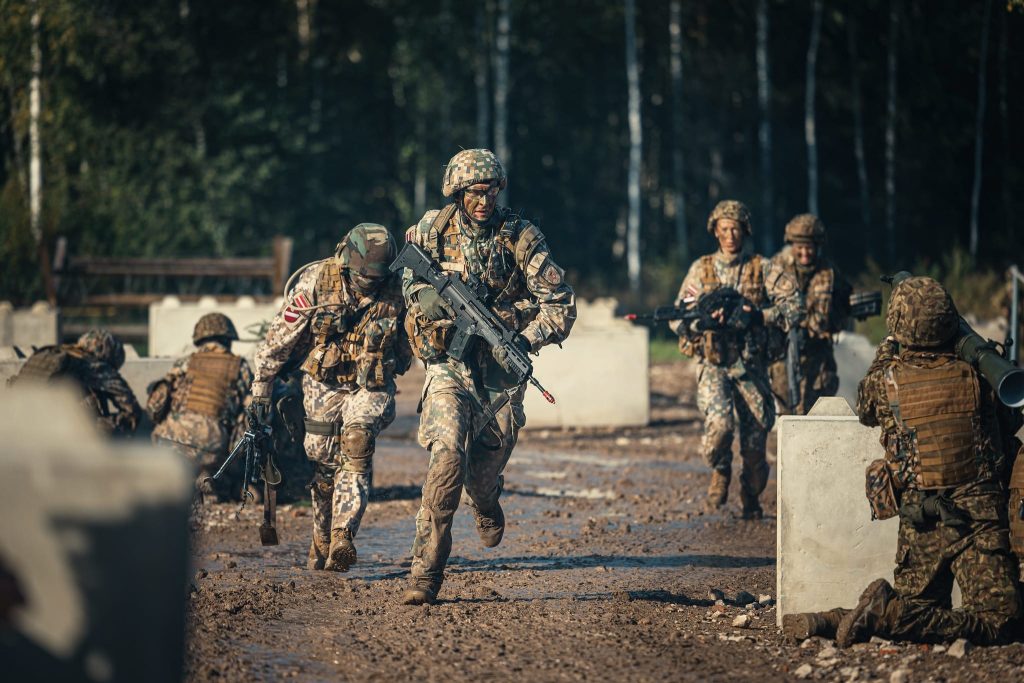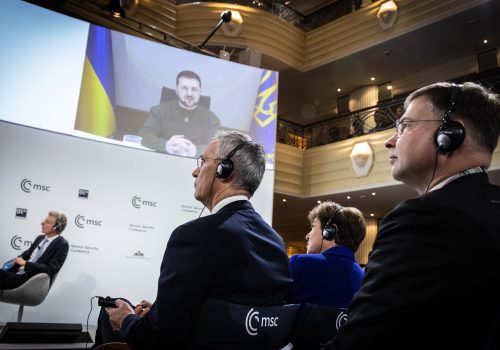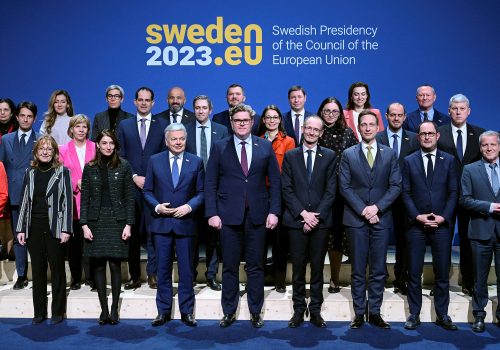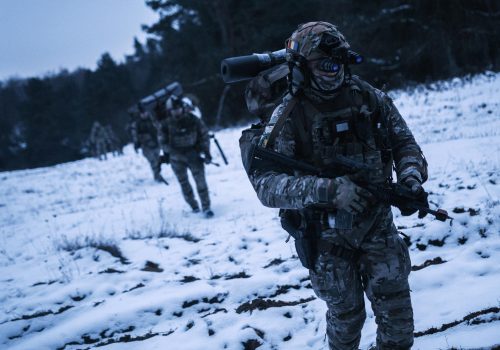Barack Obama and Donald Trump agreed on very little. Yet both former US presidents critiqued NATO allies for “free riding” off of US military power. Obama said that “free riders aggravate me” and pressured the British (seen by many as the United States’ closest ally) to spend more on defense. Trump reportedly threatened that the United States would “do its own thing” if NATO allies did not spend at least 2 percent of their gross domestic product (GDP) on defense. The free-riding critique extends far beyond Obama and Trump. The 2014 Wales summit agreement that NATO members “aim to move towards” spending 2 percent of GDP on defense within a decade has since been used by US policymakers and commentators to push for NATO allies to meet the 2 percent threshold. Has all of this criticism led to meaningful policy change? Or has it mostly created division within the Alliance?
At first glance, events since Russia’s full-scale invasion of Ukraine have seemed to validate the free-riding critique: The United States has clarified its commitment to defend NATO members, and its defense spending dwarfs the rest of the Alliance. Yet recently released evidence suggests that most of NATO’s members have increased their defense spending in the past year or plan to do so in the near term. The evidence shows that the United States’ European allies make defense spending decisions based on the threats they perceive, and US actions and criticisms are not as important as Americans would like to think.
The problem with the free-riding critique
Free riding provides a compelling explanation of collective action problems. The insight is that individual actors who can consume a public good without providing for it will do so—they will take a “free ride” off of others’ contributions. When one actor makes a particularly large contribution to the public good, potential free riders choose to rationally abstain from contributing, knowing that the good will be provided. Obama, Trump, and others who accuse NATO allies of free riding argue that the allies choose to spend less on defense than they otherwise would because of the massive US military budget and the US commitment to defend Europe against attack. In this view, US taxpayers are gullible suckers, providing security to Europeans who, in turn, spend lavishly on social welfare and infrastructure instead of ensuring their own defense.
Scholars and experts have long noted problems in applying free-riding theory to alliances such as NATO, however. First, the total amount that all NATO members spend on defense is hardly a public good. Given that each NATO member can decide to contribute to or withhold its military from NATO operations (see the “as it deems necessary” clause of Article 5), the best one can say is that NATO member defense spending contributes to the potential for a better allied defense. Second, some NATO members spend far more on their defense as a percentage of their GDP than others, and the straightforward free-riding critique cannot explain that variance even when taking into account variance in the ally’s size. Finally, collective action logic only applies if all actors agree on the nature of both the problem and the solution. If a NATO member does not see Russia as a threat to its territorial integrity, for example, it is not free riding off of US defense spending by spending 1 percent of its GDP on defense; it is providing a spending level appropriate to its perceived threat environment.
Why 2022 should have been the free-riding perfect storm
The world of 2022 seemed to provide the perfect environment for European free riding according to the logic the critics have outlined. In 2021 the United States spent $766 billion on defense, which was over twice what the rest of NATO members spent on their defense combined. Moreover, US President Joe Biden, who took office in January 2021, consistently and clearly pledged to come to the defense of NATO allies if they were attacked. After Russia’s full-scale invasion of Ukraine on February 24, 2022, the Biden administration reiterated the US commitment to defend NATO allies. The United States also sent twenty thousand additional troops to the Alliance’s eastern flank to assure the Europeans and deter the Russians, bringing the US total on the continent to one hundred thousand. If there was ever a moment for Europeans to take a free ride off of US largesse, this was it.
Economic trends and fiscal pressures provided European governments with a good reason to spend less on defense—and, conceivably, a good story to Washington as to why they were not spending more. After contracting by 6.2 percent in 2020 due to the COVID-19 pandemic, the eurozone’s GDP grew by 5.2 percent in 2021, but slumped to 3.1 percent growth in 2022 due in large part to the war in Ukraine and post-pandemic inflationary pressures. Higher interest rates to combat inflation make government borrowing more difficult, which is especially problematic given the high debt-to-GDP ratio in most European countries.
The truth about European defense spending
European NATO members’ defense spending in 2022, as collected in the recently released volume The Military Balance: 2023, provides three pieces of evidence that defy the free-riding critique.
- Sixteen NATO members (over half the Alliance) increased their defense spending in 2022 relative to 2021 in current US dollars. This was after significant increases in European defense spending in 2021. Europe was an exception to the global norm here, as global military spending declined by roughly 2 percent in 2021 and 2022, according to The Military Balance.
- In 2022, twelve NATO members increased their defense spending as a percentage of GDP. For example, Lithuania increased its defense spending from $1.3 billion to $1.5 billion (in current US dollars) and as a percentage of GDP from 2.07 percent to 2.34 percent. Given the aforementioned economic headwinds and other budgetary demands (such as pandemic expenditures and economic stimulus), increasing defense spending as a percentage of GDP was extremely challenging in fiscal and political terms. For example, the United States increased defense spending from $759 billion in 2021 to $766 billion in 2022, but defense spending as a percentage of GDP declined from 3.3 percent in 2021 to 3.06 percent in 2022.
- An additional seven NATO governments have pledged to raise defense spending as a percentage of GDP in the near term: the Czech Republic, Denmark, Italy, Latvia, Norway, Poland, and Romania. For example, in March 2022, Latvia’s cabinet approved an increase in defense spending from 2.2 percent to 2.5 percent of GDP by 2025.
What should one take away from these defense spending figures? While the United States’ massive military budget and reinvigorated commitment to defend Europe provided incentives to free ride in 2022, many of the United States’ European allies responded to the increased threat from Russia by increasing their defense spending immediately or announcing that they would do so in the coming years.
Moving past the critique
Many US policymakers and commentators argue that NATO allies free ride off of US defense spending and Washington’s commitment to defend Europe. But the evidence from the past year suggests that when NATO allies perceive extreme threats, they spend more on defense. Of course, perceptions of threats evolve over time, and as we look toward the future, we should recognize that perceptions do not always translate into immediate spending outcomes.
Two lessons emerge from this analysis. First, US policymakers would do well to stop publicly berating NATO allies for their defense spending decisions. While some private pressure may be useful (especially on the kinds of capabilities allies are spending on), public criticism is likely to divide the Alliance and is unlikely to achieve the intended outcome. Second, the United States should be less fixated on whether its behavior is encouraging free riding. European allies’ actions offer a substantial counterpoint to the free-riding critique. Washington should take notice.
Jason W. Davidson is a professor of political science at the University of Mary Washington and a nonresident senior fellow at the Atlantic Council’s Transatlantic Security Initiative within the Scowcroft Center for Strategy and Security.
Further reading
Fri, Feb 24, 2023
Experts react: How a year of war in Europe remade NATO, and what comes next
New Atlanticist By
The war has undeniably re-invigorated NATO. But just how much has changed? Our experts weigh in on the state of the Alliance and where allies should go from here.
Mon, Jan 30, 2023
Sweden has a chance to transform European security—even before it officially joins NATO
New Atlanticist By Franklin D. Kramer
Sweden can wield the agenda-setting powers of its presidency to push a EU security and defense budget directed toward three crucial aims: mobility, sustainment, and critical infrastructure protection.
Tue, May 17, 2022
NATO Forward Forces Tracker
Trackers and Data Visualizations By
In the lead-up to and following Russia’s invasion of Ukraine in February 2022, the United States and NATO allies have taken numerous steps to bolster allied force posture in Eastern Europe. The Scowcroft Center for Strategy and Security’s Transatlantic Security Initiative has been tracking it all. Check out its interactive table and charts to visualize the changes over time.
Image: Kuld?ga, Lithuania.- In the photos taken on October 3, 2022, the Lithuanian Armed Forces participate in the "Namejs 2022" military training in cooperation with the Polish Armed Forces at the "Me?aine" field in the Kuld?ga district. The Army Poland will give military and survival training sessions to civilians between the ages of 18 and 65 who request it, after starting years ago a program to expand and modernize its Armed Forces that has accelerated after the outbreak of the war in Ukraine.



